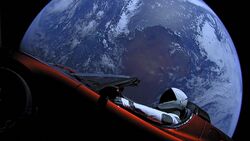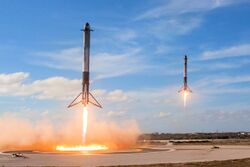Astronomy:SpaceX ambition of colonizing Mars
This article may need to be rewritten to comply with Wikipedia's quality standards. (January 2024) |
SpaceX has stated its ambition to facilitate the colonization of Mars via the development of the Starship launch vehicle. The company states that this is necessary for the long-term survival of the human species,[1] experts like Robert Zubrin support the concept due to the prevalence of water ice often found in the form of permafrost on Mars as well as the possibility of utilizing in-situ resources like carbon dioxide and nitrogen.[2] Opponents of the concept point out the lack of breathable air as well as the radiation on the surface of the planet.[3]
Elon Musk, who founded SpaceX, first presented his goal of enabling Mars colonization in 2001 as a member of the Mars Society's board of directors. In the 2000s and early 2010s, SpaceX made many vehicle concepts for delivering payloads and crews to Mars, including space tugs, heavy-lift launch vehicles, and Red Dragon capsules. The company's current Mars plan was first formally proposed at the 2016 International Astronautical Congress alongside a fully-reusable launch vehicle, the Interplanetary Transport System. Since then, the launch vehicle proposal was altered and renamed to "Starship", and has been in development since. The company has given many estimates of dates of the first human landing on Mars.
SpaceX's early missions to Mars will involve small fleets of Starship spacecraft, funded by public–private partnerships. The company hopes that once infrastructure is established on Mars and the launch cost is reduced further, colonization can begin. The Mars program has been criticized by some as far-fetched, partially because of uncertainties regarding its financing[4] and because it primarily addresses transportation to Mars and not the steps that follow. George Dvorsky writing for Gizmodo characterized Musk's timeline for Martian colonization as "stupendously unreasonable".[5] For reference, Musk's timeline for the colonization of Mars involves a crewed mission as early as 2029 and sustainability by 2050.[6]
Background
Growth of private spaceflight

Before founding SpaceX, Musk joined the Mars Society's board of directors for a short time. He was offered a plenary talk at their convention where he announced Mars Oasis, a project to land a miniature experimental greenhouse and grow plants on Mars, to revive public interest in space exploration.[7] Musk initially attempted to acquire a Dnepr ICBM for the project through Russian contacts from Jim Cantrell.[8] Russian officials were unreceptive to Musk's approach and on the flight back from Moscow, Musk worked on a spreadsheet and concluded that they could build their own rockets.[9] Over time, Musk's goal evolved from a small publicity mission to generate interest in going to Mars, to a full-scale effort to create an architecture that would enable a self-sustaining human settlement on Mars.[10] This led to the formation of SpaceX.[11]: 30–31
Reusable launch system

Tenets
As early as 2007, Elon Musk stated a personal goal of eventually enabling human exploration and settlement of Mars,[12] although his personal public interest in Mars goes back at least to 2001 at the Mars Society.[11]: 30–31 SpaceX has stated its goal is to colonize Mars to ensure the long-term survival of the human species.[4]
Starship's reusability is expected to reduce launch costs, expanding space access to more payloads and entities.[13] According to Robert Zubrin, aerospace engineer and advocate for human exploration of Mars, Starship's planned lower launch cost could make space-based economy, colonization, and mining practical.[11]: 25, 26 According to Robert Zubrin, lower cost to space may potentially make space research profitable, allowing major advancements in medicine, computers, material science, and more.[11]: 47, 48 Musk has stated that a Starship orbital launch could eventually cost $2 million, starting at $10 million within 2-3 years and dropping with time.[14] Pierre Lionnet, director of research at Eurospace, claimed otherwise, citing the rocket's multi-billion-dollar development cost and its current lack of external demand.[15]
Launch vehicle

Starship is designed to be a fully reusable and orbital rocket, aiming to drastically reduce launch costs and maintenance between flights.[16]: 2 The rocket consists of a Super Heavy first stage booster and a Starship second stage spacecraft,[17] powered by Raptor and Raptor Vacuum engines.[18] Both the rocket stages' body are made from stainless steel.[19]
Methane was chosen for the Raptor engines because it is relatively cheap, produces low amount of soot as compared to other hydrocarbons,[20] and can be created on Mars from carbon dioxide from the atmosphere and hydrogen via the Sabatier reaction.[21] The engine family uses a new alloy for the main combustion chamber, allowing it to contain 300 bar (4,400 psi) of pressure, the highest of all current engines.[20] In the future, it may be mass-produced[20] and cost about $230,000 per engine or $100 per kilonewton.[22]
Starship is the launch vehicle's second stage and will serve as a long-duration spacecraft on some missions.[23] The spacecraft is 50 m (160 ft) tall[24] and has a dry mass of approximately 100 t (220,000 lb).[22] Starship's payload volume is planned to be about 1,000 m3 (35,000 cu ft),[25] larger than the International Space Station's pressurized volume by 80 m3 (2,800 cu ft),[26] and could be larger with an extended 22 m (72 ft)-tall payload bay.[27]: 2 By refueling the Starship spacecraft in orbit using tanker spacecraft, Starship may be able to transport larger payloads and more astronauts to other Earth orbits, to the Moon (Starship HLS), and Mars.[27]: 5
Program manifest
SpaceX plans to build a crewed base on Mars for an extended surface presence, which it hopes will grow into a self-sufficient colony.[28][29] A successful colonization, meaning an established human presence on Mars growing over many decades, would ultimately involve many more economic actors than SpaceX.[30][31][32] Musk has made many tentative predictions about the date of Starship's first Mars landing,[19] including 2029.[33]
Exploration

Musk plans for the first crewed Mars missions to have approximately 12 people, with the goals of "build[ing] out and troubleshoot[ing] the propellant plant and Mars Base Alpha power system" and establishing a "rudimentary base." The company plans to process resources on Mars into fuel for return journeys,[34] and use similar technologies on Earth to create carbon-neutral propellant.[35]
Colonization and terraforming

The program aims to send a million people to Mars, using a thousand Starships sent during a Mars launch window.[36] Proposed journeys would require 80 to 150 days of transit time,[32] averaging approximately 115 days (for the nine synodic periods occurring between 2020 and 2037).[37] This plan has been described as 'pure delusion' by George Dvorsky, writing for Gizmodo,[5] and as a 'dangerous delusion' by Lord Martin Rees, a British cosmologist/astrophysicist and the Astronomer Royal of the United Kingdom .[38] Serkan Saydam, a mining engineering professor from the University of New South Wales said that we will likely still lack the technology needed to create and maintain a martian colony of a million people by 2050. [5]
Red Dragon capsule

Mars Colonial Transporter
Reception and feasibility
As of December 2023, SpaceX has not publicly detailed plans for the spacecraft's life-support systems, radiation protection, and in situ resource utilization, which are essential for space colonization.[39]
Notes
References
- ↑ Sheetz, Michael (2021-04-23). "Elon Musk wants SpaceX to reach Mars so humanity is not a 'single-planet species'" (in en). https://www.cnbc.com/2021/04/23/elon-musk-aiming-for-mars-so-humanity-is-not-a-single-planet-species.html.
- ↑ Zubrin, Robert (January 2024). "The Case for Colonizing Mars, by Robert Zubrin". https://nss.org/the-case-for-colonizing-mars-by-robert-zubrin/.
- ↑ Jackie, Wattles (12 December 2023). "Colonizing Mars could be dangerous and ridiculously expensive. Elon Musk wants to do it anyway". https://www.cnn.com/2020/09/08/tech/spacex-mars-profit-scn/index.html.
- ↑ 4.0 4.1 Chang, Kenneth (27 September 2016). "Elon Musk's Plan: Get Humans to Mars, and Beyond". The New York Times. https://www.nytimes.com/2016/09/28/science/elon-musk-spacex-mars-exploration.html.
- ↑ 5.0 5.1 5.2 "Elon Musk's Plan to Send a Million Colonists to Mars by 2050 Is Pure Delusion" (in en). 2022-06-03. https://gizmodo.com/elon-musk-mars-colony-delusion-1848839584.
- ↑ Torchinsky, Rina (17 March 2022). "Elon Musk hints at a crewed mission to Mars in 2029". https://www.npr.org/2022/03/17/1087167893/elon-musk-mars-2029.
- ↑ Elon Musk (30 May 2009). "Risky Business". IEEE Spectrum. https://spectrum.ieee.org/aerospace/space-flight/risky-business.
- ↑ Keith Cowing (30 August 2001). "Millionaires and billionaires: the secret to sending humans to Mars?". SPACEREF. http://www.spaceref.com/news/viewnews.html?id=383.
- ↑ Ball, Molly; Kluger, Jeffrey; de la Garza, Alejandro (13 December 2021). "Elon Musk: Person of the Year 2021". Time (magazine). https://time.com/person-of-the-year-2021-elon-musk/. Retrieved 4 November 2022.
- ↑ Bierend, Doug (17 July 2014). "SpaceX Was Born Because Elon Musk Wanted to Grow Plants on Mars". Vice. https://www.vice.com/en/article/jp5g8k/spacex-is-because-elon-musk-wanted-to-grow-plants-on-mars.
- ↑ 11.0 11.1 11.2 11.3 Zubrin, Robert (14 May 2019). The Case for Space: How the Revolution in Spaceflight Opens Up a Future of Limitless Possibility. Amherst, New York: Prometheus Books. ISBN 978-1-63388-534-9. OCLC 1053572666.
- ↑ Hoffman, Carl (2007-05-22). "Elon Musk Is Betting His Fortune on a Mission Beyond Earth's Orbit". Wired Magazine. https://www.wired.com/science/space/magazine/15-06/ff_space_musk?currentPage=all.
- ↑ Mann, Adam (20 May 2020). "SpaceX now dominates rocket flight, bringing big benefits—and risks—to NASA" (in en). Science. doi:10.1126/science.abc9093. https://www.science.org/content/article/spacex-now-dominates-rocket-flight-bringing-big-benefits-and-risks-nasa. Retrieved 28 November 2021.
- ↑ Duffy, Kate. "Elon Musk says he's 'highly confident' that SpaceX's Starship rocket launches will cost less than $10 million within 2-3 years" (in en-US). https://www.businessinsider.com/elon-musk-spacex-starship-rocket-update-flight-cost-million-2022-2.
- ↑ Bender, Maddie (16 September 2021). "SpaceX's Starship Could Rocket-Boost Research in Space" (in en). Scientific American. https://www.scientificamerican.com/article/spacexs-starship-could-rocket-boost-research-in-space/.
- ↑ Inman, Jennifer Ann; Horvath, Thomas J.; Scott, Carey Fulton (24 August 2021). "SCIFLI Starship Reentry Observation (SSRO) ACO (SpaceX Starship)". Game Changing Development Annual Program Review 2021. https://ntrs.nasa.gov/citations/20210020835. Retrieved 12 October 2021.
- ↑ Amos, Jonathan (6 August 2021). "Biggest ever rocket is assembled briefly in Texas". BBC News. https://www.bbc.com/news/science-environment-58120874.
- ↑ Ryan, Jackson (21 October 2021). "SpaceX Starship Raptor vacuum engine fired for the first time". https://www.cnet.com/science/spacex-starship-raptor-vacuum-engine-fired-for-the-first-time/.
- ↑ 19.0 19.1 Chang, Kenneth (Sep 28, 2019). "Elon Musk Sets Out SpaceX Starship's Ambitious Launch Timeline". https://www.nytimes.com/2019/09/28/science/elon-musk-spacex-starship.html.
- ↑ 20.0 20.1 20.2 O'Callaghan, Jonathan (31 July 2019). "The wild physics of Elon Musk's methane-guzzling super-rocket". https://www.wired.co.uk/article/spacex-raptor-engine-starship.
- ↑ Sommerlad, Joe (28 May 2021). "Elon Musk reveals Starship progress ahead of first orbital flight of Mars-bound craft". The Independent. https://www.independent.co.uk/life-style/gadgets-and-tech/space/elon-musk-starship-sn16-mars-b1855721.html.
- ↑ 22.0 22.1 Sesnic, Trevor (11 August 2021). "Starbase Tour and Interview with Elon Musk". The Everyday Astronaut (Interview). Archived from the original on 12 August 2021. Retrieved 12 October 2021.
- ↑ Petrova, Magdalena (13 March 2022). "Why Starship is the holy grail for SpaceX". https://www.cnbc.com/2022/03/13/why-starship-is-the-holy-grail-for-spacex.html.
- ↑ Dvorsky, George (6 August 2021). "SpaceX Starship Stacking Produces the Tallest Rocket Ever Built". https://gizmodo.com/spacex-starship-stacking-produces-the-tallest-rocket-ev-1847438954.
- ↑ O'Callaghan, Jonathan (7 December 2021). "How SpaceX's massive Starship rocket might unlock the solar system—and beyond". MIT Technology Review. https://www.technologyreview.com/2021/12/07/1041420/spacex-starship-rocket-solar-system-exploration/.
- ↑ Garcia, Mark (5 November 2021). "International Space Station Facts and Figures". http://www.nasa.gov/feature/facts-and-figures.
- ↑ 27.0 27.1 "Starship Users Guide". March 2020. https://www.spacex.com/media/starship_users_guide_v1.pdf.
- ↑ "SpaceX wants to use the first Mars-bound BFR spaceships as Martian habitats" . Eric Ralph, TeslaRati. August 27, 2018.
- ↑ "We're going to Mars by 2024 if Elon Musk has anything to say about it" . Elizabeth Rayne, SyFy Wire. August 15, 2018.
- ↑ Berger, Eric (2016-09-28). "Musk's Mars moment: Audacity, madness, brilliance—or maybe all three". Ars Technica. https://arstechnica.com/science/2016/09/musks-mars-moment-audacity-madness-brilliance-or-maybe-all-three/.
- ↑ Foust, Jeff (2016-10-10). "Can Elon Musk get to Mars?". SpaceNews. http://www.spacenewsmag.com/feature/can-elon-musk-get-to-mars/.
- ↑ 32.0 32.1 Boyle, Alan (September 27, 2016). "SpaceX's Elon Musk makes the big pitch for his decades-long plan to colonize Mars". GeekWire. http://www.geekwire.com/2016/spacex-elon-musk-colonize-mars/.
- ↑ Torchinsky, Rina (17 March 2022). "Elon Musk hints at a crewed mission to Mars in 2029" (in en). NPR. https://www.npr.org/2022/03/17/1087167893/elon-musk-mars-2029.
- ↑ Sommerlad, Joe (28 May 2021). "Elon Musk reveals Starship progress ahead of first orbital flight of Mars-bound craft" (in en). The Independent. https://www.independent.co.uk/life-style/gadgets-and-tech/space/elon-musk-starship-sn16-mars-b1855721.html.
- ↑ Killelea, Eric (16 December 2021). "Musk looks to Earth's atmosphere as source of rocket fuel" (in en-US). https://www.expressnews.com/business/article/Elon-Musk-SpaceX-rocket-fuel-16707544.php.
- ↑ Kooser, Amanda (16 January 2020). "Elon Musk breaks down the Starship numbers for a million-person SpaceX Mars colony" (in en). CNET. https://www.cnet.com/news/elon-musk-drops-details-for-spacexs-million-person-mars-mega-colony/.
- ↑ "Making Humans a Multiplanetary Species". SpaceX. 2016-09-27. http://www.spacex.com/sites/spacex/files/mars_presentation.pdf.
- ↑ "Elon Musk's plans for life on Mars are a 'dangerous delusion', says British chief astronomer" (in en). https://news.sky.com/story/elon-musks-plans-for-life-on-mars-a-dangerous-delusion-12243479.
- ↑ Grush, Loren (4 October 2019). "Elon Musk's future Starship updates could use more details on human health and survival" (in en). https://www.theverge.com/2019/10/4/20895056/elon-musk-starship-spacex-human-health-life-support-radiation.
External links

